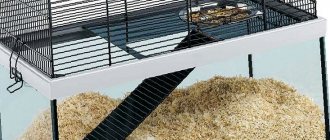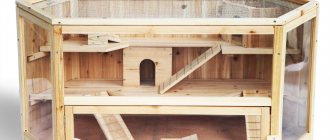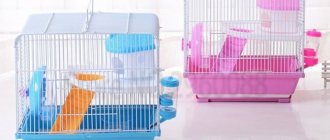- home
- Housing
16.04.2018
Almost everyone has a day when they need to properly organize their move. The difficulty often lies not in small children, but in their pets. It is imperative to find out how they tolerate this or that type of transport and how to transport it without harm to the health and life of the hamster. Choosing a carrier for an animal is not difficult, but we must not forget the rules of transportation and the necessary equipment of the home.
Air travel
You can transport your hamster over short and long distances using different types of transport. Before transporting an animal on an airplane, you need to find out how this species tolerates stress on the body. Veterinarians warn that dwarf hamsters and Syrian hamsters do not withstand such stress well. Having understood the characteristics of the rodent, you can move on to choosing a container.
It will be difficult to adapt to the requirements of the airline and the country where the hamster’s owners are moving. You need to prepare documents for export from the country in order for your pet to be allowed on the plane.
In addition to your own troubles, you can also harm your pet. You need to think 10 times before finally deciding that there is no other way to transport a hamster. The animal may not survive the air travel at all. With the above species of rodents, there is a possibility of death from stroke due to pressure surges.
Brief overview of popular models
- Plastic. Easy to clean, you can observe the animal through the transparent top. Versatile: can be used for both short trips and long trips.
- Carrying bag. Made of dense fabric, ventilation and a window for observation are provided. The animal bag is suitable for transportation over a short distance.
- With metal rods. It resembles a familiar cage for a rodent, the most budget option. The bottom is made of plastic so that filler can be poured in and it is more convenient for the pet to move around the container.
A nesting house for budgerigars: is it needed and why, how to choose and make it yourself.
You can make a simple carrier yourself.
How to make your own carrier?
How to make toys for a hamster with your own hands at home
Many people are interested in whether it is possible to make a carrier for such an animal as a hamster with your own hands. It's actually quite simple. In addition, in this way you can save additional financial resources that would be spent on purchasing a carrier for transporting an animal on a train, for example.
There are several options for homemade carriers designed for hamsters. These include:
In the first case, it is extremely important to make sure to make several holes in the transport container to allow sufficient oxygen to enter the baby’s temporary home. Otherwise he may suffocate
In the second case, you should give preference to strong, breathable fabrics, since, experiencing a feeling of strong fear and anxiety on the train, the pet may chew off part of the homemade container.
Some people prefer ordinary glass jars so that the baby cannot get hurt during the move on sharp corners, which are often present in homemade carriers made for hamsters
In addition, it is important to consider that when traveling on a train or other types of transport, the animal will still experience a shaking sensation, and therefore it is worth checking from time to time how it behaves and whether everything is okay with it. In order to understand how to make a carrier for a hamster, just watch the training videos, of which there are plenty on the Internet
Why do you need a pet carrier?
A carrier is necessary to transport the rodent outside the home. Carrying it in the hands or in the bosom is not very convenient for the owner, and it is also risky, because if it is positioned incorrectly, the animal can be injured or suffocate. And in a special carrier he will be as comfortable as in his home cage.
In what cases does the need for carrying arise:
- The rodent needs to be taken to a veterinary clinic.
- A long trip is planned by car, train or plane. To avoid leaving a rodent alone for a long period of time, many families take their pet with them on trips.
- You can take hamsters and other members of the rodent family for walks outside and visit friends.
The carriers have enough space not only for your pet, but also for his toys, water bottle and food bowl. Thanks to this equipment, even the longest trip outside the house will be comfortable and safe for the rodent.
Choosing a Carrying Bag
How to make a maze and tunnel for a hamster with your own hands
When purchasing a container for your hamster, you need to pay attention to several details:
- Carrying size. A small container is suitable for transportation. If the rodent requires a lot of free space, then you can choose a larger one.
- Material. Metal containers are practically no different from a rodent’s usual home and have a low cost. It is most convenient to use a plastic container - it is easy to wash, the hamster will not be able to chew through the hole, and there is enough light from above. Animal bags made of fabric are suitable if you need to transport the animal over a short distance.
- Price. There are both very cheap models and more expensive containers. You need to choose based on the financial capabilities of the owner and the necessary properties of the container. The main thing to remember is that low price = fragility and unreliability.
Read more about rodent carriers
Once you have decided to go on a trip with your baby and have chosen a vehicle, all that remains is to purchase a suitable carrier. These things are sold in pet stores. The range is impressive. How much a container for a hamster costs depends on the model, size, and arrangement.
Brief overview of popular models
The average price of a carrier for hamsters is 10-20 USD. For 15 USD You can purchase a high-quality ImacBaggy carrier; it is also used for chinchillas, guinea pigs, rabbits and other small animals. The model is made of durable plastic and has many air holes. The top of the model is transparent and opens on both sides. Carrying size: length 25 cm, width 36 cm, height 29 cm, this space is quite enough for a rodent during travel.
carrying
For small rodents, carriers with a handle are available that can be carried as a bag. Air holes are made at the top. This model from the Trixie company costs 10 USD.
carrying
If you want to buy a carrier cheaper, pay attention to the small cage with a handle. Differs in compact sizes.
carrying case with handle
Choosing a Carrying Bag
Carrying is necessary for travelers, but also for those who like to just walk with their pet. A small box is a good choice, the baby will be comfortable there, and he will not feel any discomfort while walking/moving.
The carriers are different:
- size;
- material of manufacture;
- color.
All of them are designed for comfortable transportation of the animal, but still have a number of differences, so it is important to choose your original and convenient model, with the optimal price-quality ratio.
The most popular carriers for hamsters:
- plastic - they are easy to wash, as a rule, the top is transparent to allow more light to enter;
- bag – has a viewing window and ventilation;
- a metal carrier is the most budget option; the advantage is that it is practically no different from an everyday home.
Animal bag
A carrier for hamsters is necessary not only for travelers, but also for walks in the fresh air. The right container will provide a comfortable home for the duration of your walk or trip.
Hamster carriers are sold in regular pet stores. You can choose a container to suit every taste and budget. The price depends on the size and model. Varies from 10 to 20 dollars. For 15 you can find a durable plastic carrier, which will have holes for air and devices for the animal’s comfort. Approximate container size for hamster comfort: length at least 20 cm, width – 30 cm, height – 25 cm.
Main types of carriers:
- The bag has a window and air flows in. Suitable for very small pets.
- Plastic ones are transparent, let in more light to the hamster, and are easy to wash.
- Metal - for those who need to save money. The advantage is that there is almost no difference from the usual rodent home.
When purchasing a carrier, you need to consider the availability of amenities:
- Containers for food and water.
- Drum, ladder and other entertainment.
Such carriers will be more expensive, but then you don’t have to worry too much about the comfort and safety of the hamster. Before going to your pet’s new home, it is better to put old sawdust, he will feel a familiar smell and will not be afraid of the journey.
Is it really impossible to do without carrying?
Special carriers and containers for hamsters are not a tribute to fashion, but a necessity that ensures the safety of the baby. Of course, if you buy a hamster and you need to bring it home from the market and you don’t plan to travel, you can use a jar. But if it breaks, the baby will suffer.
If you travel frequently, carrying your hamster's permanent home with you is inconvenient, so a carrier is necessary. It will ensure complete safety for the rodent. It is convenient for hamsters to travel in a small box; it is comfortable and warm. The stress from moving will be minimal, because everything necessary for life is available, in particular, food and drink.
How much does a hamster carrier cost?
The cost of the carrier depends on its material, the manufacturer’s pricing policy, and the filling of the container.
Plastic container
The most convenient for hamsters is a plastic container. It is spacious; if necessary, you can place not only feeders and drinking bowls in the container, but also your ward’s favorite toys. When purchasing, make sure that there are ventilation holes, the quality and environmental friendliness of the material, it should also be strong enough.
Product price:
- from 135 to 400 hryvnia (Ukraine);
- from 410 to 1,700 rubles (Russia).
Did you know? In Vietnam, keeping hamsters as pets is prohibited by law, with a fine of up to 30 million dong (approximately 50 thousand rubles). The ban is based on the fact that rodents are carriers of infectious diseases.
Ball carrier
The carrier ball is not suitable for long trips. This item is basically intended for gaming. But for short distances it can be used quite well. The advantage of the ball is that no matter how it turns over, the baby will not get hurt or injured, since the inside of the ball is soft and elastic.
The material is durable on the outside and has holes for fresh air to enter. The disadvantage of the carrier toy is that with prolonged use, the lid covering the hole wears out. To be on the safe side and not lose your pet, you can glue the lid with tape during the walk.
Balloon prices:
- from 23 to 60 hryvnia (Ukraine);
- from 252 to 749 rubles (Russia).
Shape and material of manufacture
Most models of rodent carriers are rectangular in shape. Such products are considered the most convenient for the owner and very comfortable for the pet.
In the range of carriers you can also find a ball-shaped model. The design of good strength with a hole for air penetration does not turn over, so injury to the animal is excluded. However, it is not suitable for long trips and is more often used for games and transporting the rodent over short distances.
Carriers for rodents in the form of a container are made of high-quality and environmentally friendly plastic. Some models are equipped with metal rods.
Carrying bags and backpacks are made of waterproof acrylic fabric and nylon. The products are of high quality, but do not forget about the pet’s addiction to chewing everything that is in the access area. If you are planning a long trip, it is better to avoid such carrying.
Finding the right size
The size of the carrier is determined taking into account the size of the rodent. He should be comfortable inside the accessory. You also need to calculate the capacity of the product to equip it with additional items that may be required during long trips (toys, drinking bowl, feeder).
The carrier is a convenient accessory for transporting rodents over any distance. Buy a quality product with sufficient capacity. This carrier will last for many years and will provide proper conditions for the rodent to stay in it.
After each use, clean the carrier from dirt and be sure to disinfect the bottom, aimed at destroying all kinds of germs and the unpleasant odor of feces. Use laundry soap and baking soda as disinfectants. Aggressive detergents are not suitable for cleaning the structure, as they eat into the plastic and can harm the health of the pet.
Basic rules of transportation
Before organizing the relocation of hamsters, it is worth buying a container for the hamster. It is much more convenient, adapted for transporting animals on a train, allowing the animals to bury themselves in the sawdust poured inside and sleep the entire way. The animal carrier must be equipped with containers for water and food, and in no case should it be placed in a draft or left where it is very cold. To reduce the stress of pets during transportation, it is worth following its basic rules in various types of transport.
In airplane
For hamsters, transportation by plane is highly undesirable. There is information that Djungarians and Syrians may not survive the flight at all, dying from a stroke, which occurs due to sudden changes in pressure
In addition, it is important to find out in advance the conditions for transporting animals, because when checking documents, if some of them are missing, the pet will be confiscated
By train
Transportation by train is one of the most successful “travel” options for individuals of the hamster order. The main thing is to make sure you have the following documents:
- form No. 1;
- certificate for transportation (taken from the state district clinic);
- ticket indicating “baggage with you.”
If you are planning to travel on a train for a long time with your pet, you should take care of a large number of accessories inside the temporary home so that he does not get bored and does not feel the change in the situation around him.
By car
When thinking about whether it is possible to transport a hamster in a car, you should not look for reasons to refuse such an idea. This method of transportation is considered one of the most convenient when it comes to traveling from one city to another within the same country. The animal will not need any additional certificates about its health status or vaccination. Pet carriers used in the car must be well insulated, especially in the winter. It is best to wrap them in scarves, warm blankets, and put as much sawdust and napkins inside as possible so that the pets do not freeze.
Transporting a baby according to all the rules
Airplane
The hamster can not only be taken to another city, but also outside the country. Hamster breeders claim that the Syrian hamster and the dwarf dwarf have the hardest time surviving flights. Therefore, it is important to figure out in advance how to transport a hamster on a plane and only then buy a suitable container for the hamster.
The complexity of the flight is explained by the owners of hamsters by the fact that each airline has its own rules for transporting animals, the requirements of veterinary services can differ radically, to the point that one country may require certificates that another does not. It turns out that one set of documents is required for the import of an animal, and another for the export. A veterinary passport for a hamster and vaccinations are usually not required. But a certificate to transport an animal is required. Document control in air transport is the strictest.
It is worth transporting your baby by plane only if another transportation option is not possible. The baby may not survive the flight, since these animals do not tolerate pressure surges well - a Syrian or Djungarian hamster may die from a stroke.
How to transport a hamster on a train
Definitely easier than on an airplane. Analyzing the reviews of hamster owners, we can conclude that the conductors are not happy with such passengers, since they consider them breeding grounds for diseases. But if you have the necessary documents on hand (including Form 1) and have a carrier for hamsters, there is no need to worry.
You already know how to transport a hamster - for this you need to buy a special container, put some shavings or other filler that the baby is used to. Don't forget to take food, treats, and water. There is nothing complicated in preparing the baby for moving; as a rule, the difficulties lie in collecting a package of documents.
What documents may be required when transporting a rodent:
- Form No. 1;
- certificate for transportation (this document is issued by the state district clinic);
- if you need to travel by train, buy a ticket marked “baggage with you” (as is the case with cats and dogs).
Car
When asked whether it is possible to transport a hamster in a car, the answer is yes. This is the easiest way, especially if you are moving within your own country. Certificates will only be required when crossing the border.
You need to learn how to transport a hamster in winter; when exposed to low temperatures, rodents fall into stupor. To keep your baby warm, add plenty of napkins and wrap the container in a scarf or small blanket; if possible, stay outdoors for a short time.
Documents for air travel with animals
Transporting an animal must be agreed upon with the airline in advance, as... the number of seats for pets is limited. Regardless of whether you are flying with a parrot or a goldfish, the pet must have the necessary package of documents:
- Veterinary passport.
- International veterinary certificate (for foreign flights).
- Veterinary certificate in form No. 1 (for domestic Russian ones).
- Microchipping certificate.
- Documents required by the legislation of the country of arrival (for example, a certificate of absence of infections, breeding value, etc.).
At the airport, before departure, your pet must go through control at the veterinary station.
Why do you need a carrier for hamsters?
The hamster is a small but nimble and at the same time fragile animal; it is susceptible to colds after being in the cold for a long time.
Important! If you carry a baby in your own pocket or bag, in your bosom, this can, at the very least, result in damaged clothes, in another case, injury, loss of a pet, or even death.
Therefore, when going to a pet store to buy a pet, transporting an existing one to a veterinarian, or traveling with a ward, you need to think carefully about where it will be kept during this period.
Animals, like us, experience stress, fear, and other natural desires and needs. By providing the hamster with familiar conditions in a transfer or relocation situation, you will neutralize all negative consequences. In the carrier, the hamster is, firstly, safe, and secondly, warm.
It will also be useful for you to find out what a cage for a hamster should be like, how to make and arrange an aquarium for a hamster, and also find out what a cage should be like for a Djungarian and Syrian hamster.
Temperature
When transporting a pet, you need to pay attention to weather conditions. Extremely high and low temperatures can have a detrimental effect on an animal's health.
In summer, keep the container with your pet in the shade to avoid sunstroke. Hamsters do not tolerate cold easily, especially frost. It is possible to transport a hamster in winter, but you need to monitor your pet more closely. If he is exposed to cold air for a long time, he may fall into a stupor. Place napkins in the carrier and cover the container with a scarf or blanket. It is important to keep your hamster warm.
Parrots and other birds on an airplane
After cats and dogs (read the rules for transporting them here), the most popular pet passengers are birds. First of all, because a much larger number of airlines are ready to accept them on board than, for example, fish or rodents. The parrot's flight must be coordinated with the airline no later than 48 hours before departure. And at the same time, find out the exact requirements for a container for transporting birds. The cage must be strong and have a secure lock. All accessories inside the cage (bowls, branches, toys) are secured (tied to the rods).
All toys and other accessories must be securely attached to the bars of the cage during the flight.
The bird can be transported in the cabin or luggage compartment. It’s better in the salon - the owner can correct the shortcomings in time and just talk to the pet. In addition, the luggage compartment has poor ventilation, which can cause serious injury to the bird.
How to prepare a bird for air travel
Birds are transported in a cage or carrier bag; it is better to introduce the pet to its temporary home in advance Read: What to do if your luggage is lost during a flight
A few tips to help reduce your bird's stress during air travel:
- To make it easier for your feathered pet to endure the journey, it must be accustomed to the cage in advance.
- You should bring a dark cloth with you to cover the cage during the flight (some airlines provide such a cover).
- If at home the parrot prefers to live a free life, before going on the road it is better to accustom it to a long stay in the confined space of the cage.
- Often a week before the trip, the bird is given stress vitamins. But only an ornithologist veterinarian should prescribe it.
- Before the flight, the bird should be given something to drink, and fresh, liquid-rich fruits should be placed in a bowl.
How to transport hamsters: food
Use dry grain food for hamsters, and instead of water, you can use pieces of juicy vegetables or fruits (not citrus fruits). Apples, carrots, bell peppers, cucumbers, tomatoes, eggplants and grapes are suitable - they will prevent dehydration.
The answer to the question of how to transport hamsters is not complicated: following the above tips will ensure the comfort of your little pets.
Caring owners very often faced the problem of transporting their pets. The cold season causes particular inconvenience for small rodents. First of all, if you carry a hamster in your hands, it can run away, and the owner, dressed in a thousand clothes, cannot deftly catch him. Also, exposure to low temperatures can cause detrimental harm to the animal. Therefore, when you plan to transport your hamster to new owners in winter, you should approach this issue as seriously as possible.
How to make a carrier for a hamster with your own hands
If buying a ready-made carrier for some reason is not your option, you can make it yourself. For this purpose, you need to purchase a food-grade plastic container (preferably rectangular in shape), with a lid and handles of a suitable size.
Food-grade plastic guarantees that your child will not breathe harmful fumes during transportation.
DIY hamster carrier: video
Tools and materials
Tools and materials required for work:
- food plastic container;
- soldering iron;
- a soft belt or handle from an old bag.
Manufacturing process
The production diagram looks like this:
- Using a soldering iron in the upper part of the lid, at a distance of approximately two centimeters from the corner, we solder a narrow groove so that the holder from the drinking bottle can be secured in it. For ease of use, it is better to remove the lid from the container.
Then try the lid on the container box and remove a piece of plastic at the point where the container wall comes into contact with the drinking bowl mount. Place the drinker in the mount, mark the place for the hole for the drinker spout in the wall of the container. Solder a hole of the required size so that the spout fits freely inside the container.
Next, to prevent the pet from suffocating, we solder holes in the form of parallel strips in the three corners of the container in the lid, two or three are enough. The fourth corner of the lid, near which the drinking bowl is attached, is left untouched.
The final stage is to equip the carrier with everything necessary for the hamster’s comfort:
- Place a feeder with dry food on the bottom.
- Scatter sawdust around the bottom of the feeder, level it and compact it.
- Tie a soft long belt to the lids of the container, old handles from a bag, you can sew a handle from existing scraps of fabric. Adjust the length of the handles for your own convenience, and it is better to tie them obliquely so that the box does not warp during transportation of the pet.
- Close the lid and install the drinker, lift the handles up and click into place. The carrier is ready.
Types of carriers for rodents: popular models
Pet stores offer a large selection of carriers for rodents. Such designs vary in size, material and design.
Types of carriers for pet rodents:
- Plastic containers are convenient and roomy designs made from safe food grade plastic. It is equipped with a carrying handle and ventilation holes that ensure free penetration of air into the product. Easy to clean and wash.
- A carrier with lattice metal walls and a plastic bottom. Pros: excellent ventilation, full visibility for the pet.
- Soft nylon and rubberized carrier bags. They are light in weight, have a comfortable handle and nylon mesh on the sides to ensure air flow. Convenient for transporting rodents on public transport.
- A backpack carrier is a convenient option for cyclists and lovers of hiking with a rodent. The product with a rigid frame is equipped with a viewing window and ventilation holes in the side walls.
Fish on the plane
The main difficulty with transporting fish on an airplane is that they live in water. And its volume, as a rule, exceeds 100 ml - the maximum limit for liquid in one bottle in the aircraft cabin.
Therefore, the vast majority of airlines refuse to transport fish.
Most likely, the aquarium fish will fly in the trunk
For example, Aeroflot airline is not ready to accept them in any form, just like rodents. If you can find a carrier that is prepared for such unusual passengers, most likely they will fly in the luggage compartment. Please note that airlines are not responsible for the safety of fish.
What to transport fish in
Aquarium fish are transported in a strong, sealed container without corners or dangerous elements. The most popular options are a jar, thermos or plastic container. However, it is better to use multi-layer sealed bags. This way, when shaking, the fish are not injured by the walls of the container. The package is placed in a box (usually foam).
How to prepare for air travel of aquarium fish
The bag cannot be filled completely with water and oxygen; under pressure during the flight it may burst. Rules for air travel of fish:
- Before the flight, the fish need to fill the aquarium with fresh water - preferably 3 degrees below the usual norm. This will make the journey easier for them.
- The fish are moved into containers or sealed bags before departure and the recently replaced water is poured into them. The ratio of water to air is 2:1.
- A more preferable option is to ask the pet store to fill the container with water, saturating it with oxygen at the same 1:2 ratio.
- Do not overfill the container with oxygen or air (the surface of the bag should be slightly pressed when pressed). At flight altitude, the pressure decreases and the volume of air increases.
- Before the trip, the fish are not fed for a day - well-fed fish consume more oxygen.
- Do not transport many fish in one container. At a minimum, 1 liter of liquid is required for one 5-centimeter individual.
- The container must be darkened - fish tolerate stress more easily in the dark.
- During the cold season it is necessary to provide heating. For example, cover a bag with waterfowl pets with heating pads.
Read: Carry-on luggage on an airplane, size and weight, what you can carry
Travel by rail
It's easier here than in the air. But the majority of those who transported pets in this way are clear that the handlers do not really like such passengers, since they are convinced that they are contagious. Therefore, you must take the appropriate documents and a carrier for your hamster.
The carrier can be purchased in the form of a container for transporting animals. Place shavings or other filler there for the hamster's convenience. And take his favorite food. There is nothing difficult about it.
You must have the following documents with you:
- Form No. 1.
- Certificate of permission for transportation.
- When purchasing a train ticket, indicate “baggage with you.”











